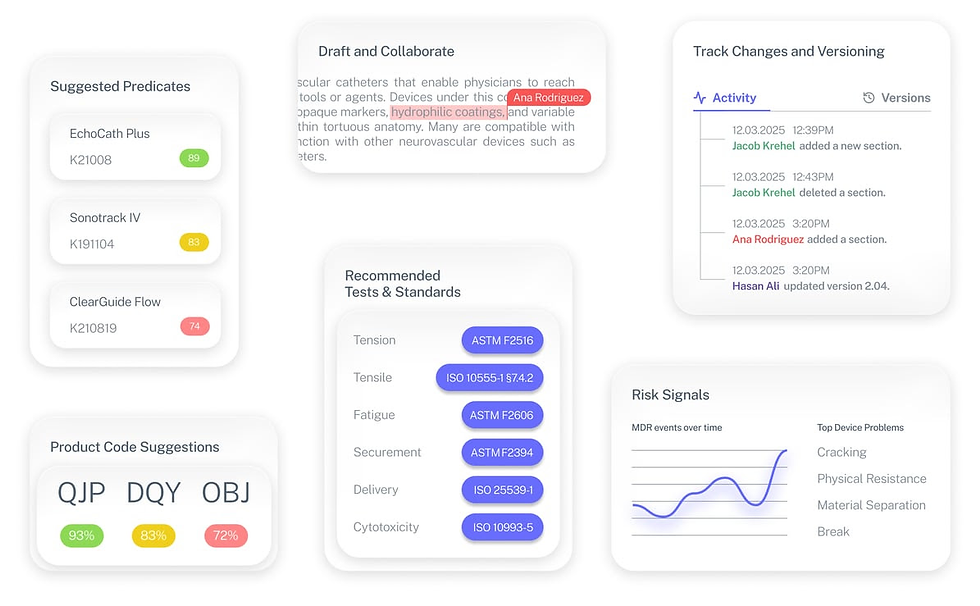Which FDA Pathway for SaMD? 510(k), De Novo, or PMA (2025)
- Beng Ee Lim

- May 15
- 3 min read
Updated: Sep 7
Choosing a SaMD pathway depends on risk, novelty, and predicates. Use 510(k) when a suitable predicate exists for the same intended use and technology (often Class II). Choose De Novo for novel, low–moderate-risk software without a predicate—creating a new classification. Use PMA for Class III/high-risk devices that must demonstrate safety and effectiveness.

Here’s how to tell:
Pathway | When It Applies | Typical Risk |
510(k) | Predicate exists and risk is low-to-moderate (FDA Class II or Class I “reserved”) | IMDRF II–III |
De Novo | No predicate and overall risk is low-to-moderate (cannot be Class III) | IMDRF II–III |
PMA | High-risk / critical care software (life-supporting, life-sustaining, or high-impact diagnostic) | IMDRF IV |
Why Choosing the Right SaMD FDA Pathway Matters
If you pick the wrong FDA submission route, the cost isn’t just money—it’s 8–12 months of delay, team fatigue, and missed revenue.
Each pathway:
Has different timelines
Requires different supporting evidence
Triggers different regulatory expectations
So how do you know which one fits your SaMD?
When 510(k) Is the Right Path
510(k) is the most common FDA submission type—and for many SaMDs, it’s exactly what you need.
✅ You qualify if:
There’s an existing predicate device with the same intended use
Your software presents moderate risk
You can demonstrate substantial equivalence
👉 Examples:
AI for diabetic retinopathy screening (predicate: IDx-DR)
Cardiac rhythm classifiers
Decision support software for non-critical conditions
Bonus: many SaMD submitters now use the FDA’s eSTAR template, which can speed up review and improve formatting compliance.
When De Novo Applies Instead
If your software is moderate risk but has a, you’re in De Novo territory.
Key signs you need De Novo:
You can’t find a similar 510(k) cleared product
You’re targeting a novel application
Your risk level is acceptable, but your innovation is first-of-its-kind
👉 Example: IDx-DR — De Novo # DEN180001: autonomous AI software that analyzes retinal fundus images to flag adults with diabetes who have more-than-mild diabetic retinopathy for specialist referral. No predicate existed—De Novo approved.
🧠 Note: Once a De Novo is granted, future similar products can then use it as a predicate
for their own 510(k).
When PMA Is Required
If your software:
Directly manages or treats a critical condition
Impacts survival or high-risk therapeutic outcomes
Or involves life-sustaining decisions without human review
👉 You likely need a Premarket Approval (PMA).
PMA is:
The most burdensome route
Requires clinical trials, human factors testing, and robust validation
Can take 12–24+ months
👉 Example: SecondLook Computer-Aided Detection System — PMA # P010038: image-analysis software that flags suspicious regions on digital mammograms so radiologists can catch potential breast-cancer lesions that might be missed on first read.
Time & Cost Comparison Table
Pathway | Avg. Review Time | FDA Fee (2025) | Notes |
510(k) | 90–150 days | $24,335 ($6,084 small biz) | eSTAR encouraged |
De Novo | 150–270 days | $162,235 ($40,559 small biz) | No predicate needed |
PMA | 12–24 months | $540,783 ($135,196 small biz) | Requires clinical trials |
⚠️ Costs don’t include consultant or testing fees.
The Fastest Path to Market
No more guesswork. Move from research to a defendable FDA strategy, faster. Backed by FDA sources. Teams report 12 hours saved weekly.
FDA Product Code Finder, find your code in minutes.
510(k) Predicate Intelligence, see likely predicates with 510(k) links.
Risk and Recalls, scan MAUDE and recall patterns.
FDA Tests and Standards, map required tests from your code.
Regulatory Strategy Workspace, pull it into a defendable plan.
👉 Start free at complizen.ai

FAQs
Q: Can I convert a De Novo into a 510(k)?
Not exactly. But once a De Novo is granted, it becomes a predicate that others can reference in their 510(k) submissions.
Q: What if I upgrade the algorithm after clearance?
You may need a new 510(k) or submit a Predetermined Change Control Plan (PCCP) in advance. FDA wants predictability.
Q: Does EU MDR classification affect my FDA pathway?
Not directly—but if your software is Class IIb or III in Europe, it may signal De Novo or PMA needs in the U.S.



